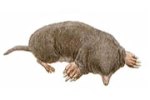Control Your Mole In Minnesota Part 3
Moles are active day and night throughout the year, but they are most active near the earth’s surface during the spring and fall on damp days or following rain showers. When the ground surface becomes frozen in the winter, or very dry during the summer, moles use only the deeper burrows. Daily peak activity periods are during the morning hours, although moles may be seen working off and on throughout the day and night.
Mating occurs during February and March, with a single litter of three to five young born later in the spring following a six-week gestation period. Young moles grow rapidly and leave the nest to fend for themselves at about one month of age.
Biology and Reproduction
|
Adult weight: |
|
|
Total length: |
7 inches. |
|
Color: |
Grayish-brown. |
|
Gestation: |
42 days. |
|
Litter size: |
Three to five. |
|
Litter number: |
One litter per year, born March to early April. |
|
Weaning: |
1 month. |
Mole Control by Trapping
Trapping is the most reliable method of mole control. The key to success is patience, practice, and persistence. Moles have an uncanny ability to detect and spring improperly set traps. So place traps carefully, and keep trying until experience leads to success.
When and Where to Trap. Generally, trapping is easiest and most effective during the spring and fall, when mole activity is at a peak. Once mole activity is noticed, control efforts should begin as quickly as possible to keep damage to a minimum. Also, trapping in the early spring can eliminate pregnant females, thereby reducing the likelihood of having to contend with a family of moles.
If you have seen indentations in your lawn, or small mounds and are not sure what they are, it is time to call your Minnesota Wild Animal Management representative.
Biology and Behavior
|
Adult weight: |
3-4 ounces. |
|
Total length: |
6-8 inches. |
|
Color: |
Gray to silvery-gray. |
|
Gestation: |
42 days. |
|
Litter size: |
3-5. |
|
Life span: |
3 years. |





